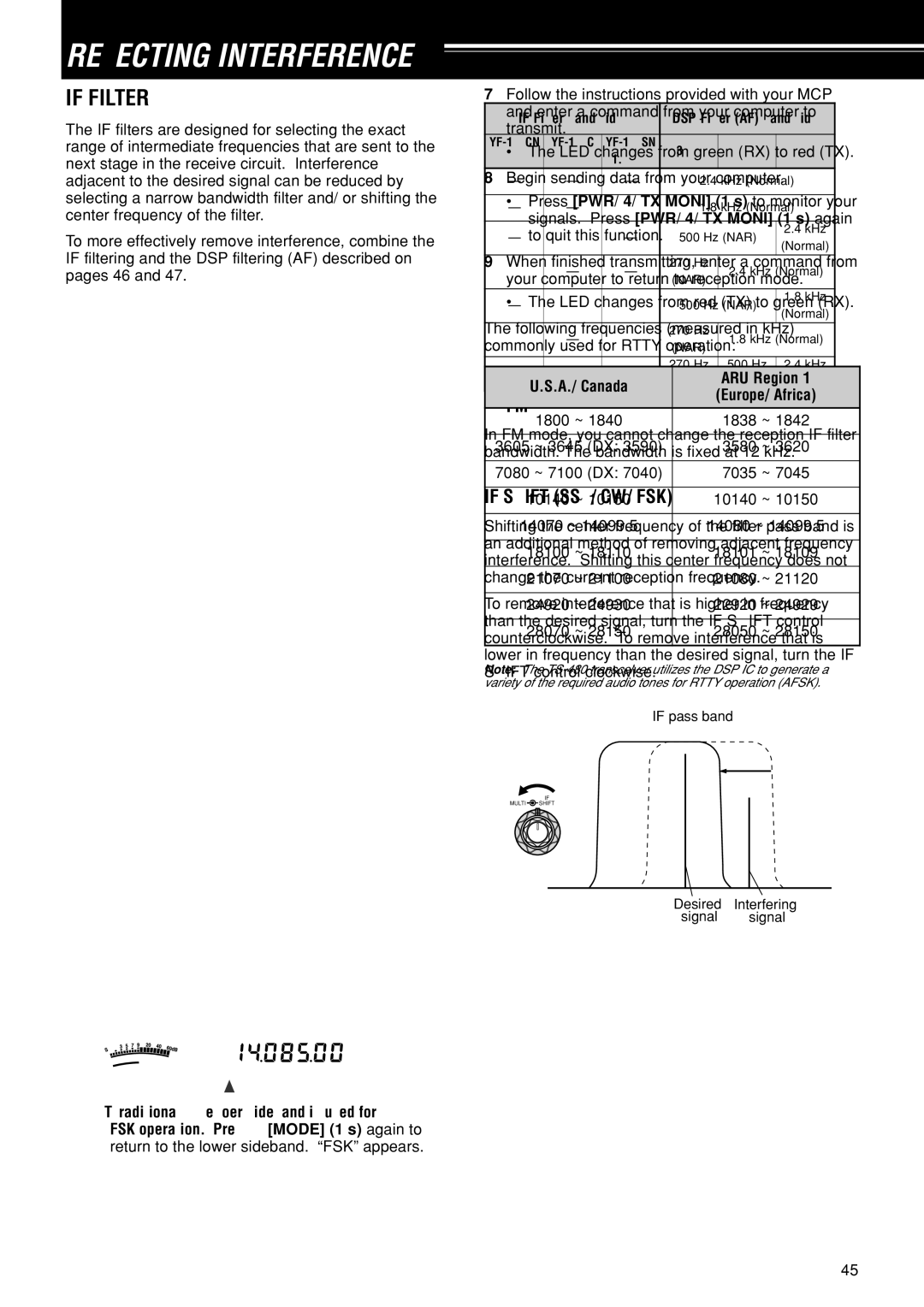
REJECTING INTERFERENCE
IF FILTER
The IF filters are designed for selecting the exact range of intermediate frequencies that are sent to the next stage in the receive circuit. Interference adjacent to the desired signal can be reduced by selecting a narrow bandwidth filter and/ or shifting the center frequency of the filter.
To more effectively remove interference, combine the IF filtering and the DSP filtering (AF) described on pages 46 and 47.
CHANGING THE IF FILTER BANDWIDTH
When adjacent frequency interference is present at both sides of the desired signal, narrowing IF filter bandwidth may be the best way to remove the interference. Changing the filter bandwidth will not effect the current reception frequency.
You can install 2 optional IF filters for SSB, CW, and FSK modes. After installing the optional filters {page 81}, the transceiver automatically recognizes what type of optional filters are installed.
■SSB/ AM
When you operate the transceiver in SSB or AM mode, you can manually select the wide or narrow filter.
Press [FIL/ NAR] (1 s) to select another IF filter.
•Each press of [FIL/ NAR] (1 s) changes “ ” (Normal) / “NAR”, then back to “ ” (Normal).
•If Menu No. 17 is ON (default is OFF) and 2 IF filters have been installed, you can select secondary IF filter. In this case, each press of [FIL/ NAR] (1 s) changes “ ” (Normal) / “NAR” / “NAR 2”, then back to “ ” (Normal).
Mode | IF filter bandwidth | ||
|
| ||
Normal | Narrow | ||
| |||
|
|
| |
SSB | 2.4 kHz | 1.8 kHz1/ | |
500 Hz2/ 270 Hz3 | |||
|
| ||
AM | 6.0 kHz | 2.4 kHz | |
|
|
| |
1Optional
2Optional
3Optional
■CW/ FSK
When you operate in CW or FSK mode, the wide filter or narrow filter is automatically selected according to the DSP filter bandwidth that you select.
The following table describes how the optional filter is selected as you change the bandwidth of DSP filter. You cannot manually select the IF filter. To change the DSP filter bandwidth, refer to “CHANGING THE DSP FILTER BANDWIDTH” {page 46}.
IF Filter bandwidth | DSP Filter (AF) bandwidth | |||||
|
|
|
|
|
| |
~ 300 Hz | ~ 600 Hz | ~ 2.0 kHz | ||||
270 Hz | 500 Hz | 1.8 kHz |
|
|
| |
— | — | — | 2.4 kHz (Normal) | |||
|
|
|
|
|
| |
— | — | ✓ | 1.8 kHz (Normal) | |||
|
|
|
|
|
| |
— | ✓ | — | 500 Hz (NAR) | 2.4 kHz | ||
(Normal) | ||||||
|
|
|
|
| ||
|
|
|
|
|
| |
✓ | — | — | 270 Hz | 2.4 kHz (Normal) | ||
(NAR) | ||||||
|
|
|
|
| ||
— | ✓ | ✓ | 500 Hz (NAR) | 1.8 kHz | ||
(Normal) | ||||||
|
|
|
|
| ||
✓ | — | ✓ | 270 Hz | 1.8 kHz (Normal) | ||
(NAR) | ||||||
|
|
|
|
| ||
✓ | ✓ | — | 270 Hz | 500 Hz | 2.4 kHz | |
(NAR 2) | (NAR) | (Normal) | ||||
|
|
| ||||
|
|
|
|
|
| |
■FM
In FM mode, you cannot change the reception IF filter bandwidth. The bandwidth is fixed at 12 kHz.
IF SHIFT (SSB/ CW/ FSK)
Shifting the center frequency of the filter pass band is an additional method of removing adjacent frequency interference. Shifting this center frequency does not change the current reception frequency.
To remove interference that is higher in frequency than the desired signal, turn the IF SHIFT control counterclockwise. To remove interference that is lower in frequency than the desired signal, turn the IF SHIFT control clockwise.
IF pass band
IF
MULTI ![]() SHIFT
SHIFT
Desired Interfering
signal signal
45
